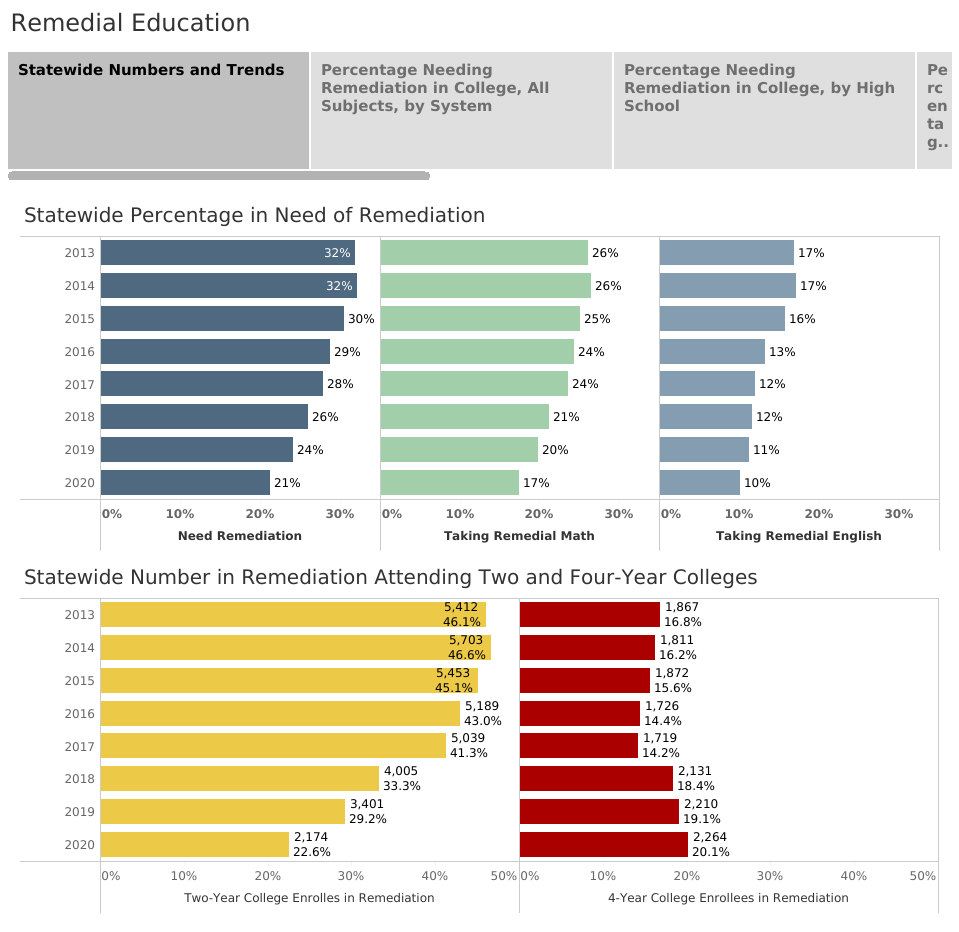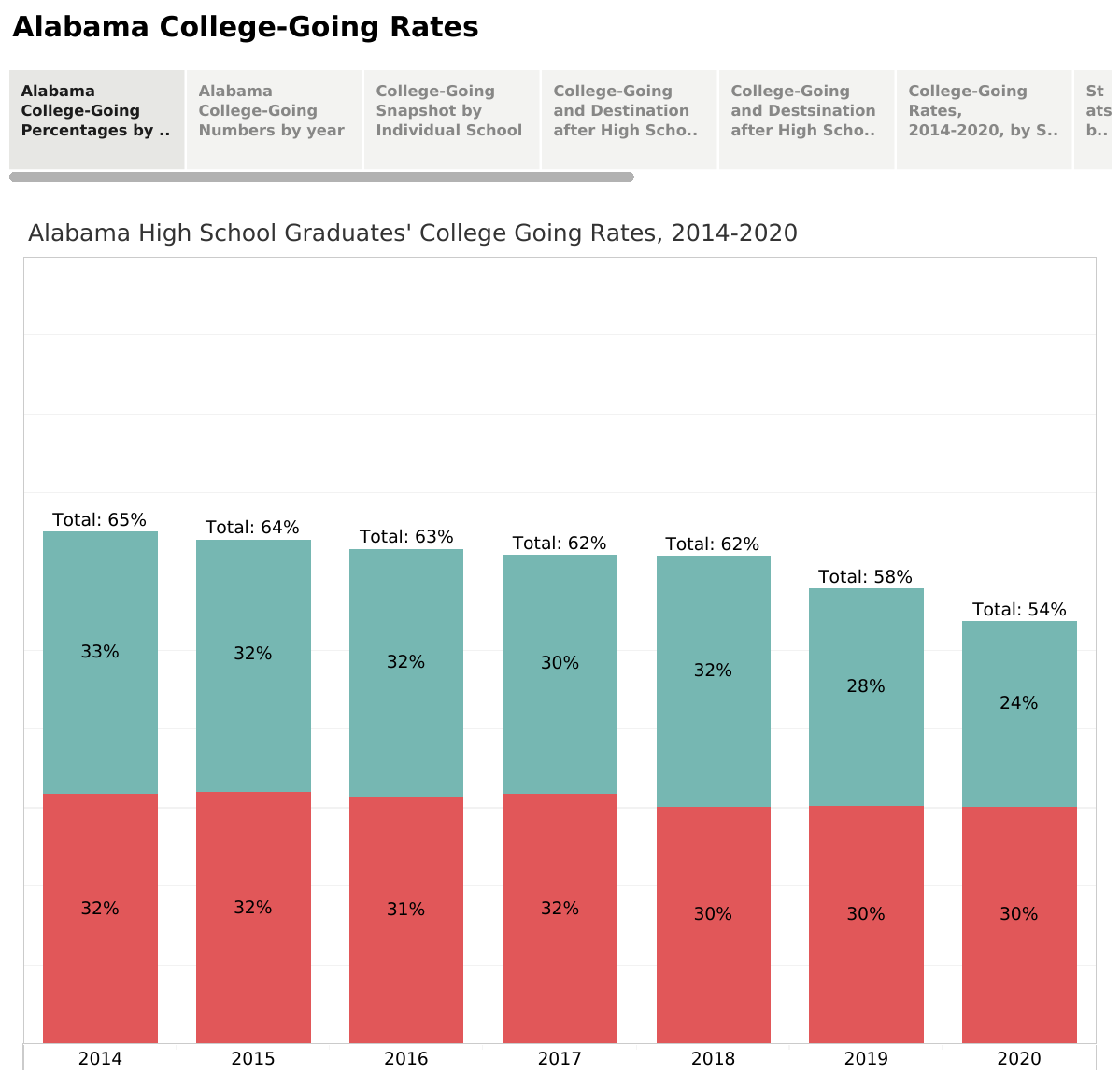
Despite the disruptions of the pandemic, Alabama high school graduates who entered college in 2020 were less likely to be assigned to remedial education and thus should be in a better position to succeed in college. The new figures released by the Alabama Commission on Higher Education (ACHE) show a continued decline in the number and percentage of students taking remedial classes in their first year, particularly among those entering community college.
Some of the declines might be attributable to fewer students going to college after high school. Only 54% of the Class of 2020 went on to college in the year after graduating high school, down from college-going rates above 60% in recent history. However, because the remediation rate among those who went to college was down and the decline in rate was concentrated at community colleges, the numbers indicate that the new approach to remedial education instituted by the two-year college system is working.
Remedial classes are non-credit college courses covering material students should have learned in high school. A student taking a remedial class is paying for a course that won’t count toward a degree. Low-income students can use Pell grants to help pay for the courses, but that can also lead to an exhaustion of Pell eligibility before degree completion. That extra cost and delay in progress are known to lower completion rates for students assigned to remedial education. High schools have been urged to improve preparation for college-bound students, which may account for some of the improvement over time. Still, since much of the drop has been in community colleges, the success in recent years points toward innovations in policy at the two-year schools.
Community Colleges Providing Alternatives
Alabama’s Community College System (ACCS) alternative to remediation has not only decreased the number of students being placed in remedial courses, but the colleges have also seen a rise in passage rates in their college-level math and English classes.
In 2018, The Alabama Community College System (ACCS) made system-wide changes designed to reduce the number of students enrolled in remedial courses (also known as developmental courses). Students were still assessed for their levels of academic preparation upon enrollment, but instead of being assigned to either regular or remedial courses, the system created other options. Students who needed extra support could be placed in a tutorial course alongside college-level math or English. Since the change, the number of students in remedial classes has declined, but the percentage of students passing gateway English and math has increased.
Meanwhile, the number of students assigned to remedial courses at four-year colleges has increased modestly. For years, the bulk of remedial education took place in the community college system. Now the number of students taking remedial classes is about equally divided between two and four-year schools. More students are assigned to remediation in math than in English, though the gap has narrowed as both rates have declined.
The report data from ACHE provides feedback to high schools about how prepared their graduates are. Use the tabs and arrows in the visualization to explore the data. Compare the performance of graduates from your local high school or system to other systems or schools.
This remediation data is the final dataset that looks back on students who graduated in the Spring of 2020. For that school year, PARCA previously published analyses of performance on ACT and WorkKeys, graduation and college and career readiness, and on college-going.
Progress Toward an Educational Goal
Decreasing the number of Alabama public high school graduates needing remediation in college was a goal identified in Alabama’s strategic plan for education, Plan 2020, adopted in 2012.
Remedial education is considered a waste of money for both the state and the individuals paying for higher education. Remedial courses cover material that should be learned in high school. Remedial classes cost students tuition and fees but do not produce credits that count toward graduation. By avoiding remedial courses, students can complete college work more quickly and at less cost.
Are entering college students better prepared?
Since 2012, Alabama has pursued multiple strategies to improve K-12 education and produce high school graduates better prepared for college and careers.
Most directly tied to college preparation, the state has increased support for dual enrollment, which allows high school students to take courses at colleges, and for Advanced Placement courses, college-level courses taught by high school faculty members.
Despite those efforts, scores for Alabama high school graduates on the ACT, the college-readiness test given to all students, have been flat to slightly declining. And while the number of students assigned to remediation has decreased in the two-year system, as noted, the number of remedial students has risen at four-year colleges.
Conclusion
Remediation is needed for students enrolling with a major gap in their readiness for college. Given the open admissions policy in the two-year system and for some four-year colleges, remedial courses continue to play a role in higher education. For others who need some help rising to the level of college coursework, it benefits students and schools to provide alternatives to remediation. The most straightforward solution is to improve preparation in high school, and those efforts should continue. The two-year system’s strategy to provide simultaneous tutoring rather than sequential remedial courses appears to benefit students, increasing passing and progression rates. The model ACCS has developed should also be explored for replication at four-year colleges.

